Table of contents
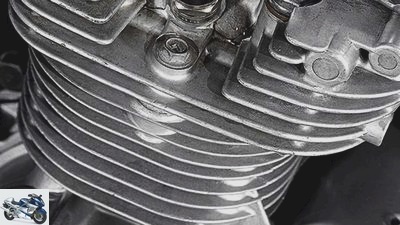
Photos: Manufacturer
motorcycles
Engine cooling technology: air cooling will soon be obsolete?
Technology: engine cooling
Air cooling will soon be obsolete?
Suzuki has been cooling the Bandit engines with water for a long time, BMW is working on the water jacket for the Boxer and the V2 from Moto Guzzi is water up to the cylinder feet. Will the cooling fin soon be obsolete? MOTORRAD collected information, opinions and forecasts.
Ralf Schneider, Eva Breutel
04/28/2011
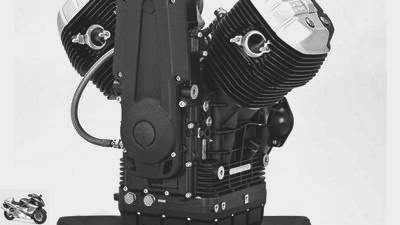
Moto Guzzi
Cooling fins are bulky and take up a lot of space. With approximately the same displacement, a water-cooled engine would be much more delicate.
Cooling fins do the same thing as the big ears of elephants: They increase the area for heat exchange, so they ensure that a heated body can be better cooled by the surrounding air. That is a simple technical task, nothing more. Nevertheless, air-cooled engines that have proper cooling fins on the cylinders and their heads are a matter close to the heart for many people. They are considered beautiful, simple, original. Whether in the Porsche 911, the Ducati Monster or the Yamaha XJR 1300. Even their loud crackling and crackling when cooling down has emotional added value.
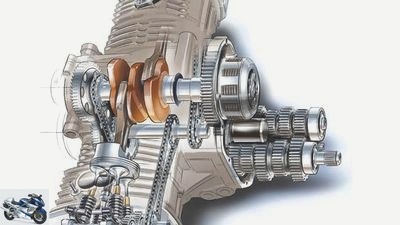
S-Kraft.net
The BMW water boxer under development, here still as a drawing, but already close to the later original, will probably have some cooling fins.
Why water cooling?
As a cooling medium, water can do the task intended for the air and the cooling fin much better. It absorbs the heat more quickly and releases it again more quickly, which is why we cool down when bathing in water at 24 degrees Celsius, but when walking in the same warm air we tend to overheat rather than shiver. Transferred to engine technology, this means that water cooling can dissipate much more heat than air cooling, however cleverly designed. Oil is also only about half as good as water when it comes to dissipating heat. The particularly heat-endangered areas around the spark plugs and exhaust ducts of an engine benefit to an exceptional degree from water cooling, and this has far-reaching consequences. If the heat is dissipated well, an engine can produce more of it first. So the designers optimize the gas exchange, the compression, the ignition point and the combustion process and increase the engine speed. In short: you increase performance. In addition, efficient water cooling also significantly improves the smoothness, reliability and longevity of an engine. The coolant jacket dampens its hard mechanical noises, compensates for temperature differences between individual areas, enables tighter piston clearances and thereby reduces pollutant emissions and wear. On the other hand, water cooling goes hand in hand with the installation of a water pump, thermostat, cooler, electric fans and a varied hose loop, which is only rarely aesthetically pleasing. If so, these components are hidden rather than revealed.
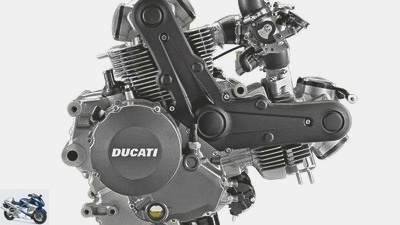
Ducati
Ducati Monster 1100 Evo: It borders on a miracle that Ducati manages to protect the exhaust zone of the rear cylinder, which is shielded from the airstream, from death by heat.
Favorable conditions in motorcycles.
Because motorcycles are light and blown by the wind, many of them with air-cooled engines can comply with the current noise and pollutant limit values as well as meet the driving dynamics requirements of today’s customers. Those who do not want to be successful in racing have enough reserves with around 100 hp for all traffic situations. The majority of large air-cooled motorcycle engines are now near the 100 hp mark; they require between 1079 (Ducati Monster 1100 Evo) and 1251 cm³ (Yamaha XJR 1300) for outputs from 95 to 110 hp. The 110 PS (R models), but even more so the 133 PS (HP2 Sport) that BMW gets from the 1170 cm³ of the DOHC two-cylinder boxer can confidently be regarded as an engineering masterpiece in this environment. This was confirmed by a Porsche engineer who is still very familiar with the last air-cooled six-cylinder boxers in the company’s own 993 series.
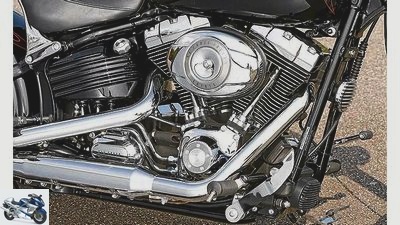
Fact
With the Rocker C, even the reservoir for the dry sump lubrication has cooling fins. With 73 hp from 1585 cm³ in a well-ventilated motorcycle, the twin-cam engine manages without an oil cooler, unlike the touring models with fairing. The sporty XR 1200 with a four-cam Sportster engine also received an oil cooler.
“Well, please, go with a cooling fin”, you could say now. But it’s not that simple. When conditions deteriorate and air-cooled engines behind sweeping fairings work to propel heavy touring motorcycles with a full load over long stretches of motorway, then constructions with lower specific power balance on the verge of heat collapse. It is no coincidence that Piaggio Head of Development Romano Albesiano first thinks of a touring motorcycle when he outlines the application area of a future, water-cooled Guzzi engine. The rear cylinders of Harley Big Twins and Victory Freedom Engines used in touring models would probably sing a lament too, if they could. Harley-Davidson then works with all the tricks in order to be able to remain true to the American engine building tradition. As with the air / oil-cooled Suzuki engines of blessed memory, the piston crowns are sprayed with cooling oil from below, and the Touring models are the only Big Twin carriers to have an oil cooler in addition to the heat-radiating dry sump reservoir. The thermal management goes so far that the rear cylinder is automatically shut down shortly before the heat death. And just in case you still have the water-cooled motors of the V-Rod series. Ducati veteran Gianluigi Mengoli, who under the aegis of Fabio Taglioni helped design the Ducati vertical shaft motors, frankly admits that the two-valve V2 of the Monster 1100 Evo and the Hypermotard 1100 Evo is actually an air / oil-cooled motor. In the hot zone around the spark plug, an increased flow of oil flows past additional inner cooling fins, in each cylinder there are two oil lines to the heads instead of just one as before, and the oil cooler has been enlarged. You can see that the pure theory of air-cooled, richly ribbed engines without special heat exchangers has had its day in motorcycle engine construction.
Air cooling as a cultural problem.
The example of Japanese engineers shows that the same physical conditions are interpreted very differently in different cultures. While their European and American colleagues work in detail and with all the tricks to further exhaust the air cooling, they have a pronounced need for security. According to insiders, there is a gentleman’s agreement among Japanese motorcycle manufacturers to comply with particularly strict limit values that they have set themselves for exhaust and noise emissions in order not to impose further restrictions on politicians. That is why a Honda CB 1300 with 116 hp from 1284 cm³ needs a water-cooled engine, on whose smooth surfaces the cooling rib does not even appear as a decorative element. The CB 1100 retro bike with its classic air-cooled four-cylinder engine is only allowed to develop 88 hp. Because its market chances in HP-spoiled Europe with this performance are too small, it is not even offered here. Kawasaki even allows the newly launched W 800 only 48 hp, but still exports it to Europe. “48 HP was enough back then”, many W-800 fans comment on this reminiscence of old English parallel twins.
Preliminary conclusion:
The intended use and the maximum output of a motorcycle engine still decide the question of cooling fin or water jacket. Air cooling is sufficient up to around 100 HP with ample displacement. If, however, the exhaust gas limit values become stricter and the durability of exhaust gas cleaning is legally stipulated, the designers themselves have to further exhaust the potential of water-cooled engines. The effort to maintain air cooling and cooling fin will then increase enormously – not a favorable prospect.
Related articles
-
Technology: engine technology super sports car
fact 23 pictures fact 1/23 The Honda Fireblade has been a great performer for twenty years. PS takes a close look at the development of engine…
-
Guide: Technology – engine lubrication
BILLION counselor workshop Guide: Technology – engine lubrication Guide: Technology – Motors and Drive Everything about engine lubrication To ensure…
-
Technology: BMW S 1000 RR engine in detail
BMW 13th pictures Artist 1/13 The on-board tool kit of the BMW almost ties in with old traditions. With the help of the nine-part set you can strip the…
-
MV Agusta F3 engine: the technology
manufacturer counselor technology & future MV Agusta F3 engine: the technology Technology: MV Agusta F3 engine The engine of the super sports car from MV…
-
counselor technology & future Technology: MZ 1000 S engine Technology: MZ 1000 S engine Something that takes a long time…… ……finally drives well,…
-
Technology of the new Ducati engine
counselor technology & future Technology of the new Ducati engine Technology of the new Ducati engine Now it’s getting tight 13 years ago, the four-valve…
-
Tips for mechanics: Maintenance of motorcycle cooling systems
Ralf Petersen 15th pictures Ralf Petersen 1/15 We explain how the maintenance of a cooling system works. Ralf Petersen 2/15 This is needed for…
-
PS reader question about motorcycle technology – cleaning the radiator
www.factstudio.de, Joachim Schahl 7th pictures archive 1/7 Picture gallery, technical question: cleaning coolers. Werner Koch 2/7 When the delicate…
-
Is the Ducati engine exhausted?
motorcycles Is the Ducati engine exhausted?? Is the Ducati engine exhausted?? This is the limit Ducati’s V2 has almost a liter of displacement – that’s…
-
motorcycles Report: BMW engine from China Report: BMW engine from China China Xcountry You don’t see it and you don’t hear it. Yeah, you don’t even feel…